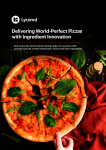Herb blend sold as sodium benzoate alternative
qualities could prove a natural alternative to sodium benzoate in
beverages, claims its inventor.
Against a broad industry backdrop where natural ingredients are proving a hot number, sodium benzoate, a common preservative, has been called into question since it was included in the highly publicised Southampton study, which concluded that there is a link between certain cocktails of additives and hyperactivity in children. Vic Cherikoff came up with the idea for Herbal-Active, which is marketed variously as a preservative, flavouring and surface mould inhibitor (depending on concentrations), after scanning scientific literature to gain an understanding of Australian food herbs' properties. "I try to identify industry challenges, and find a natural food that could overcome that," he told FoodNavigator.com. Cherikoff, who runs a company called Vic Cherikoff Food Serveices, found that all the herbs he selected for the final blend has a preservative effect in its own right - then theorised on the synergism that could take place between them. It turns out he was right. The combination yielded a preservative effect that was more than 30 times greater than the sum of the parts, he claims. Cherikoff would not reveal what plant extracts are included in the blend, since it is a proprietary formula that he does not plan to patent due to the expense and the level of disclosure that would entail. If the species and the type of extraction were divulged, people could change the concentrations by 20 per cent and see 80 per cent of the benefit, he said. But he did say that they are Australian culinary herbs, and thus need only be labelled as 'herb extracts' - and can be accompanied by the claim 'preservative-free'. Moreover, Cherikoff has been selling the herbs in the UK since before 1997, which means there is no need for Herbal-Active to go through the novel foods approvals process. Cherikoff said that the ingredient has been soft launched and is presently being trialled for use by a "major juice company". It is also being considered for a range of other products, he said, and has shown promise in a low pH beverage, a juice-based supplement, sauces and condiments, neutral pH preserved cheeses, a fruit juice concentrate and a range of skin care cosmetics. In terms of uncovering more applications, however, Cherikoff prefers to supply samples and allow companies to conduct their own trials. But he did note, however, that Herbal-Active has little to no activity against lactic acid bacteria. This means it could have a role in protecting fermented dairy and meat products from spoilage, while not affecting lactic acid fermentation or probiotic bacteria. Interestingly, the first customer was a university in New South Wales, which runs a pilot dairy factory supplying indigenous cheeses. The dairy is located next to a vineyard, so the cheese was fermenting as a result of the yeast in the air. Cherikoff says that the problem was successfully solved using his herb ingredient. Although Herbal-Active is marketed as a flavouring as well as a preservative, the impact on taste only comes at higher usage levels, Cherikoff said. For microbial use against bacteria and yeast it only needs to be 0.02 to 0.05 per cent of the finished product, depending on the pH level (the lower the better). To inhibit moulds, however, ten to 20 times greater concentration would be needed, so it would lend an herbaceous flavour with a slight liquorice note. In fact, this quality has been tapped in the case of a pate. A higher concentration of Herbal-Active was used in a gel on top of the product, thus giving flavour and inhibiting mould at the same time. Following SupplySide West in the US at the beginning of this month, he says he has already received some 50 sample requests. As for the herbs, they are wild harvested or grown on organic plantations. He said that they are not certified organic, but the very low levels required in finished products means they fall below the organic levels required for disclosure on finished product labels. Cherikoff employs five high-capacity subcontractors to carry out extractions, and does one himself. Moreover, since the ingredient is required only at a level of 0.05 per cent in beverages, it is easy to ship as an emulsion, he said. More information is available at www.cherikoff.net





















